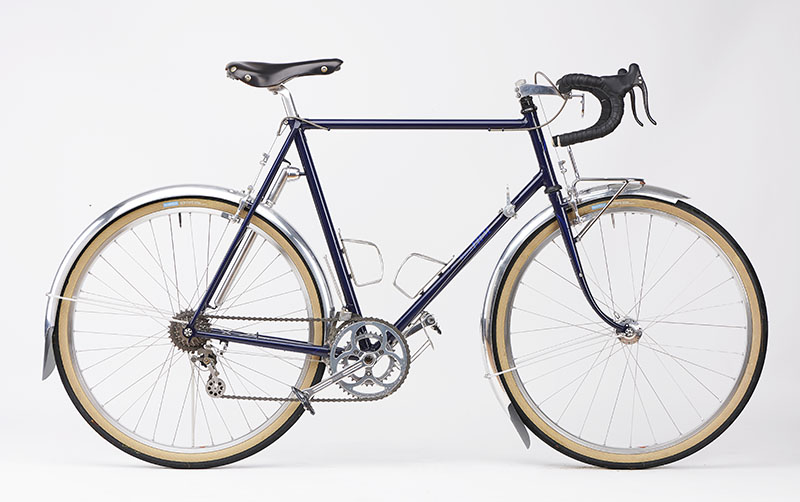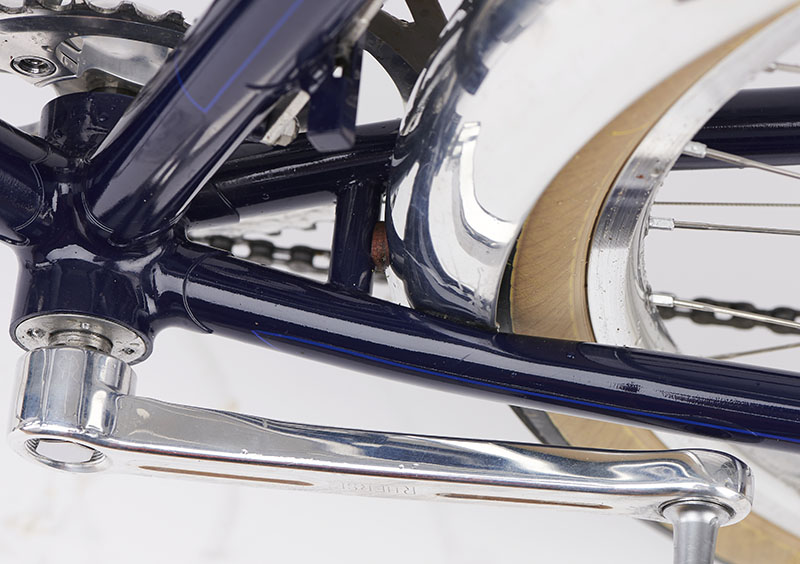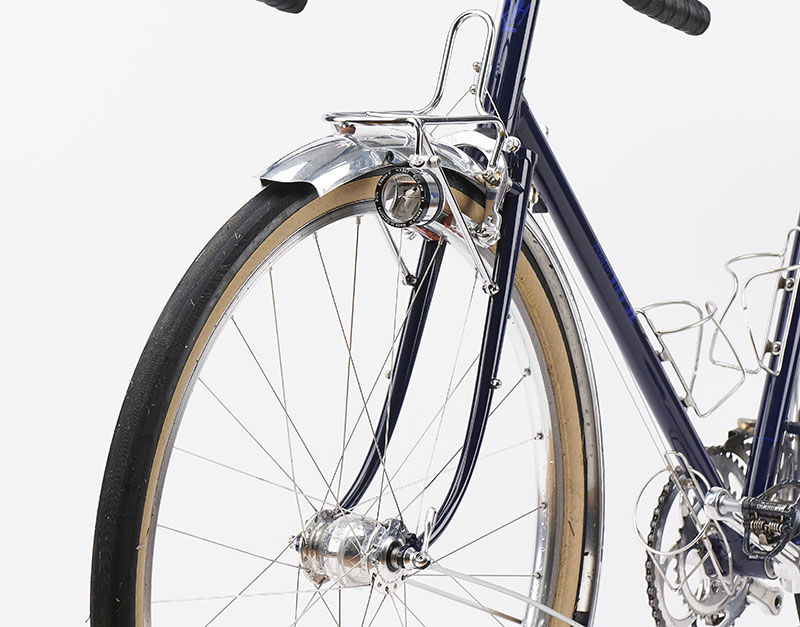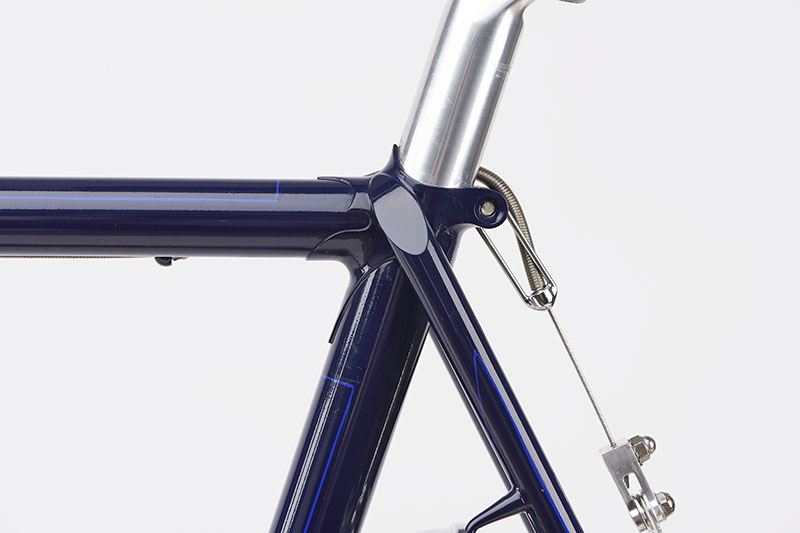My PBP Bike: The Frame

When I asked readers which part of my bike for last summer’s Paris-Brest-Paris they wanted to hear more about, the answer was: “Everything.” So we’ll make a series of short posts about the parts of the bike. I’ve already talked about the centerpull brakes here. Today, let’s look at the frame.
It’s no secret that I love my titanium Firefly. I’ve also enjoyed some great rides on carbon bikes. I wanted a very lightweight bike, and I seriously thought about getting a titanium frame or adapting a carbon U.P.P.E.R. to create a randonneur bike. In the end, I opted for steel because it’s easier to fabricate a frame that accepts all the things I need for adventures like Paris-Brest-Paris: fenders, lights, a rack, a pump…
As far as performance goes, the best bikes are virtually indistinguishable. My Firefly, the U.P.P.E.R. and my new Rene Herse all perform equally well under my pedal strokes. What matters most are the flex characteristics of the frame – what we call ‘planing’ – and my favorite bikes are remarkably similar in feel and performance, regardless of their frame material.
Of course, not all steel is created equal: The Kaisei Superlight tubeset has ultra-thin walls and custom butting profiles for light weight and just the right amount of flex. It’s heat treated for strength and durability, so it should last almost forever despite pushing the limits of what is possible in a lightweight steel frame.
In theory, a carbon bike would be lighter and a little faster uphill, but the weight difference between the lightest carbon frames (950 g) and my new Herse (1834 g) is about one full water bottle. I don’t really notice whether my bottle is full or empty when I climb a mountain pass…
Most of all, it’s hard to create a fully integrated randonneur bike from titanium and especially carbon. Compromises made necessary by a lack of braze-ons and other components would have increased the weight of the complete bike, and negated the savings on the frame alone.

Steel is very strong and stiff, so the tubes can be slender. That is a big advantage for the chainstays, where you’re fighting to fit big tires (and fenders) between road cranks with narrow Q factor. My bike uses a prototype for the Rene Herse bottom bracket shell, which has a wider socket angle, so it works seamlessly with the curved Kaisei chainstays.
There is excellent clearance for 42 mm-wide tires and fenders – and I can run my cranks on a short 107 mm BB spindle to put the chainline on the big ring (which I use most of the time). The resulting Q factor of 139 mm is narrow by today’s standards – and this really helps my spin.

Steel also is a great material for the fork: It can flex without fatiguing. (Carbon has to be stiff, as it would delaminate if it flexes too much.) The Kaisei ‘TOEI Special’ fork blades are slender at the bottom to offer a significant amount of ‘passive’ suspension. It’s a difference you really feel when the road gets rough.
Steel is easy to bend, so the fork blades are raked with more offset than is available on off-the-shelf forks. The resulting low-trail geometry optimizes the bike’s handling with a handlebar bag and wide tires. Adding braze-ons is easy, too, and the direct-mounts for the centerpull brakes help reduce the weight further.

There is another reason why I chose steel, and that one is purely aesthetic: I love the look of a finely crafted lugged frame. Mark Nobilette, who built my Rene Herse frame, is a master of his craft. He welded the lugs from pieces of steel tubing and filed them to a minimalist pattern modeled on Rene Herse’s 1940s bikes.
The beautiful, understated paint was applied by J. P. Weigle. It’s so thin that the crisply filed lug edges really show. The paint has proven very durable, too, with not a single chip despite quite a few hard miles, as well as air and rail trips to Paris and back. The lining and lettering by Donn Trethewey, a local friend and hot rod artist, adds a nice final touch.
The result is a bike that looks as light as it feels on the road. And light it is: The complete bike weighs just 10.2 kg (22.5 lb) with wide tires, fenders, rack, lights, three bottle cages and a pump. (Pedals, too – so many bike specs forget about them.)

During the 1200 km Paris-Brest-Paris, the bike’s performance exceeded my (very high) expectations. PBP is always a magic event, and it’s even more magic on a bike that feels perfectly in sync with my pedal strokes hour after hour, hill after hill. A ride of 56+ hours is long by any standards, but I can honestly say that I enjoyed every hour of it.
For ‘naked’ bikes, ti and carbon are great materials. For a fully equipped randonneur bike, steel remains my top choice.
Other parts of this series:
- My PBP bike: the wheels
- My PBP bike: contact points
- Why I choose centerpull brakes
- My PBP bike: fenders
- My PBP bike: rack and bag
- My PBP bike: lights
- My PBP bike: derailleurs


